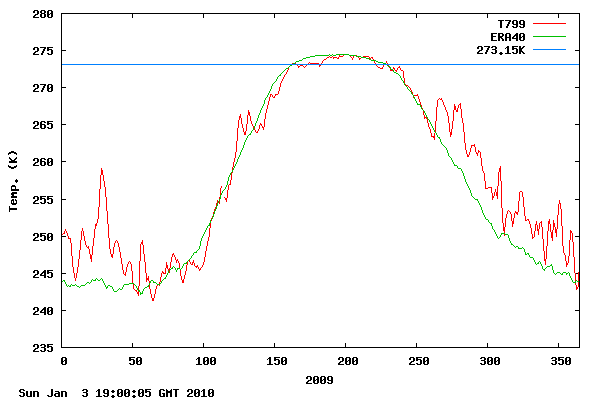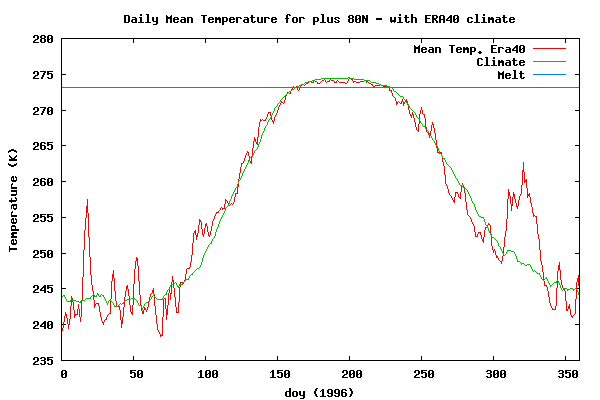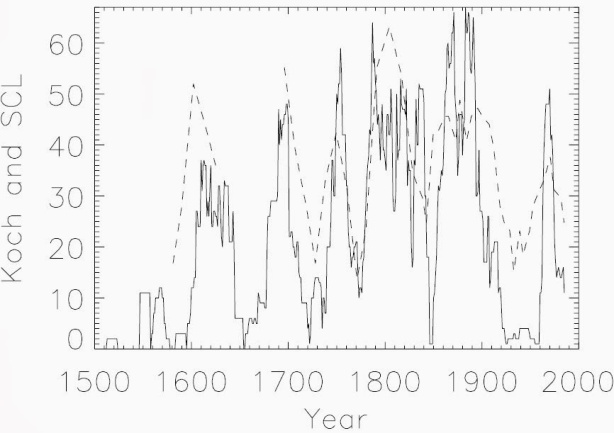|
|
Post by throttleup on Aug 8, 2013 23:23:12 GMT
All,
Can anyone postulate why, in the chart below,almost every line gets a "bump" near the end of the melt period where ice goes up... but then shortly thereafter goes down for a while more before making the turn upward?

|
|
|
|
Post by trbixler on Aug 8, 2013 23:28:53 GMT
No idea except the 2013 appears to be the earliest bump. Although on second thought maybe when the ice refreezes it pushes some ice into warmer water and that ice melts faster than the refreeze higher in the arctic.
|
|
|
|
Post by douglavers on Aug 9, 2013 4:55:46 GMT
I had not seen the WUWT page when I wrote the above. Someone called Crosspatch made the interesting observation: "Nearly the entire polar region is below 0C with many areas nearing -5C www.esrl.noaa.gov/psd/map/images/fnl/sfctmp_01.fnl.gif" Looking at the animation, the swirl is centered over the North Pole. When I was at school, seawater froze at -2degC. This suggests to me that, if anything, this storm will encourage freezing of any open water, if the temperature is mostly below -2. The other interesting point is that even quite high land temperatures can fall quickly once heat starts being lost to space. There is little heat capacity in land areas. When this happens, reported global temperatures will fall quickly, as many Arctic land areas have been quite hot until recently. I wonder what the IPCC will say if the global anomaly is negative against the 30 year satellite average in September? |
|
|
|
Post by icefisher on Aug 9, 2013 8:52:03 GMT
Most interestingly, yet another Arctic Storm is currently happening up there, the third one his summer! The question is, so what? hmmm. This is the end Beautiful friend This is the end My only friend, the end Of our elaborate plans, the end |
|
|
|
Post by magellan on Aug 9, 2013 13:53:30 GMT
Most interestingly, yet another Arctic Storm is currently happening up there, the third one his summer! The question is, so what? hmmm. This is the end Beautiful friend This is the end My only friend, the end Of our elaborate plans, the end Maybe Tstat should ask Alice |
|
|
|
Post by trbixler on Aug 10, 2013 1:54:06 GMT
|
|
|
|
Post by sigurdur on Aug 10, 2013 3:02:54 GMT
Every day now, a chance of recovery in temps disappears.
The good thing is less heat is leaving earth so maybe the rest of us can warm up?
|
|
|
|
Post by thermostat on Aug 10, 2013 3:21:49 GMT
Following up on the Arctic Weather report from the other day, first off, Iceskator, you have demonstrated quite convincingly by your comments that you are a total moron. I suggest that you get a clue; and good luck, bro.
Meanwhile, reality continues to occur in the Arctic. That is reality, not ideology. What we are observing is sea ice behavour in an unusually cold summer. (See the chart in the post above).
The weather pattern this summer has been unusually conducive to Arctic Sea Ice retention. For example, there has been next to no ice export via the Fram Strait, as persistent low pressure has dominated the Arctic. What is of interest to those who are actually curious, is what this summer is telling us about how the system works.
|
|
|
|
Post by sigurdur on Aug 10, 2013 4:41:01 GMT
What do you think it is telling us?
|
|
|
|
Post by cuttydyer on Aug 10, 2013 5:39:51 GMT
What's are the possible causes of this unusually cold Arctic summer? The Danish Meteorological Institute's Arctic temperature model suggest this has been the coldest summer since 1958, so something significant must be happening in the troposphere? I note that the Arctic also experienced below average summers in 2009 and 1996 when solar activity was extremely low:    |
|
timb
New Member

Posts: 45 
|
Post by timb on Aug 10, 2013 6:45:44 GMT
Are arctic CCW low pressure storms like hurricanes that leave a cold SST as the pass and suck heat out of the ocean? If that storm that threatens sea ice is cooling the ocean, the answer to both low sea ice and colder ocean temperatures is apparent.
A super-long shot might be micro-magnetic field variation influences on electrolyte solutions. That's my fringe theory of the day. There are scientific papers on it in a small scale, but nothing that correlates anything the sun is doing. Not sure what type of field size or timeline would affect saline transport in the ocean.
|
|
|
|
Post by cuttydyer on Aug 10, 2013 9:02:24 GMT
There's this: Lassen and Thejll paper: “close correlation found between solar activity and Arctic Ocean climate.”  A paper published by the Danish Meteorological Institute finds a remarkable correlation of Arctic sea ice observations over the past 500 years to “the solar cycle length, which is a measure of solar activity. A close correlation (R=0.67) of high significance (0.5 % probability of a chance occurrence) is found between the two patterns, suggesting a link from solar activity to the Arctic Ocean climate.”  Knud Lassen and Peter Thejll Abstract: The extent of ice in the North Atlantic varies in time with time scales stretching to centennial, and the cause of these variations is discussed. We consider the Koch ice index which describes the amount of ice sighted from Iceland, in the period 1150 to 1983 AD. This measure of ice extent is a non-linear and curtailed measure of the amount of ice in the Greenland Sea, but gives an overall view of the amounts of ice there through more than 800 years. The length of the series allows insight into the natural variability of ice extent and this understanding can be used to evaluate modern-day variations. Thus we find that the recently reported retreat of the ice in the Greenland Sea may be related to the termination of the so-called Little Ice Age in the early twentieth century. We also look at the approximately 80 year variability of the Koch [sea ice] index and compare it to the similar periodicity found in the solar cycle length, which is a measure of solar activity. A close correlation (R=0.67) of high significance (0.5 % probability of a chance occurrence) is found between the two patterns, suggesting a link from solar activity to the Arctic Ocean climate. Paper link: www.dmi.dk/dmi/sr05-02.pdf |
|
|
|
Post by Andrew on Aug 10, 2013 10:18:24 GMT
Following up on the Arctic Weather report from the other day, first off, Iceskator, you have demonstrated quite convincingly by your comments that you are a total moron. I suggest that you get a clue; and good luck, bro. The name is Iceskater. I wonder what rattled your cage? I can only imagine you are now rushing to defend Icefisher!  Are you an American too?  |
|
|
|
Post by glennkoks on Aug 10, 2013 12:58:50 GMT
Following up on the Arctic Weather report from the other day, first off, Iceskator, you have demonstrated quite convincingly by your comments that you are a total moron. I suggest that you get a clue; and good luck, bro. Meanwhile, reality continues to occur in the Arctic. That is reality, not ideology. What we are observing is sea ice behavour in an unusually cold summer. (See the chart in the post above). The weather pattern this summer has been unusually conducive to Arctic Sea Ice retention. For example, there has been next to no ice export via the Fram Strait, as persistent low pressure has dominated the Arctic. What is of interest to those who are actually curious, is what this summer is telling us about how the system works. Thermostat, I think you highlighted one of the arguments that I see all to often on these boards. Weather patterns well within their normal range being used to confirm or deny man's effect on the climate. If this year's persistent low pressure is attributed to conducive weather patterns can't last years weather patterns also be attributed to it's record low? |
|
|
|
Post by magellan on Aug 10, 2013 16:36:11 GMT
What do you think it is telling us? That is the quote of the year, hands down. Will Dr. Thermospock understand the question?  |
|